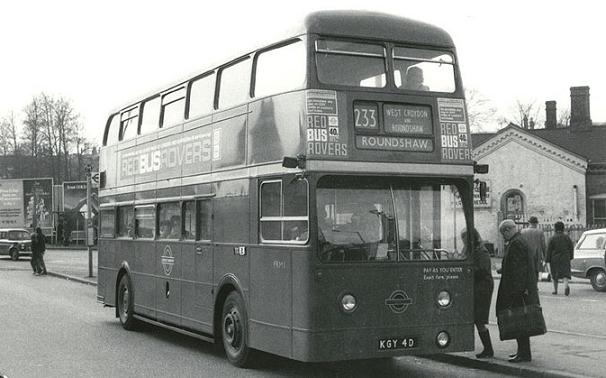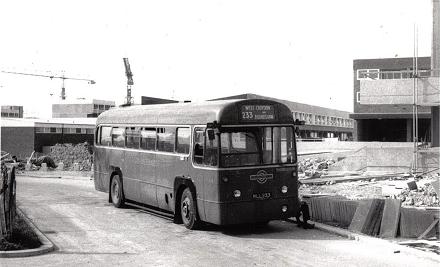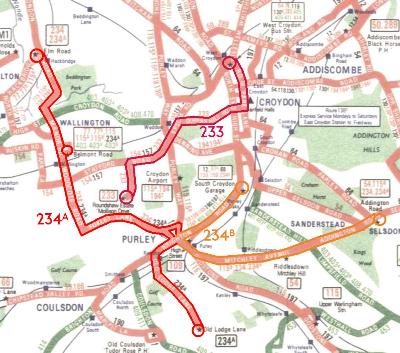|
|
Red RF routes
Route 233 (Croydon)
Page last updated 27 July 2019
|

|
FRM1, you were the future once.
Roundshaw route 233 was pioneered by one-man
operated RFs, but became the first double-deck one-man operated
route in London.
The FRM later took over another RF-pioneered
single-bus route, the 284 Potters Bar
circular. |
Dates of RF operation
31 May 69 to 21 Nov 69
(total 6 months, all OMO)
Destinations
WEST CROYDON and ROUNDSHAW (Mon-Sat)
RF Garages
 Reason for single-deck operation Reason for single-deck operationAt the time of introduction, only single-deckers were
available for one-man operation. This changed within six
months (read on...).
The Roundshaw Estate develops
around the new terminus as RF515's driver takes a rest in warm
weather on 12 Jul 69, six weeks into the new route's operation.
Photo Peter Osborn
collection
Route history
A new route in 1969 to serve the developing Roundshaw estate to
the west of Croydon, the (new) 233 started with a single RF.
This ran over the new Croydon flyover when opened, although during
the first few weeks a temporary routeing via the Flyover slip road,
South End and Southbridge Road had to be used as the new facility
was not quite ready for traffic.
The 233 used a purpose-built turning circle at Roundshaw,
adjacent to the Neighbourhood Centre. This turning circle was on
the north side of Mollison Drive, just east of Lindbergh Road. The
turning circle was lost during the building of the new
Phoenix community centre.
Within 6 months, however, the route shot to stardom as the first
double-deck one-man operated route in London. The
experimental Atlanteans, the XA class, had completed their
(crew-operated) trials on trunk routes 67 and 76, and other
uses had to be found for them. They were converted to
use fare boxes and XA22 started work on 22 November, replacing the
RF.
The FRM had also worked with the XAs and, after a short spell at
Chiswick, went to Croydon in December 1969 and settled into
regular work on the 233 while the XAs spread OMO operation to
other routes in the area. A little more than a year later, in
March 1971, the 233's frequency was increased, but it was converted
back to single-deck, now Swifts. The FRM moved on to the
234 alongside XAs again, before taking on
another former RF route, the 284, at
Potters Bar.
In December 1971, the route was joined by the 233A,
serving Roundshaw from Wallington in the other direction, on
Saturday shopping hours with one Swift. The Swifts on the
233 and 233A were replaced in their turn by
double-deckers, in the form of DMSs this time, in January
1973, capacity increasing at each step. The 233 was extended
along the 233A routing on Mondays to Fridays outside the
peaks, in 1976, and absorbed the route completely in 1978.
The route was withdrawn in 1981, when trunk route 154 was diverted to serve Roundshaw, which it
still does today. Thus the tentative start with a single RF
grew to being a substantial service.
 Thanks to Paul Richards for providing additional
details from Graham Donaldson's book 'The Routemaster Years in
Croydon & District'. Thanks to Paul Richards for providing additional
details from Graham Donaldson's book 'The Routemaster Years in
Croydon & District'.
RF route in detail, with timing points
WEST CROYDON Bus Station, Wellesley Road, Park Lane,
Croydon Fairfield
Halls, non-stop via Croydon flyover and Duppas
Hill Road, Stafford Road, Purley Way
Stafford Road, Stafford Road, Mollison Drive,
ROUNDSHAW Neighbourhood Centre
Terminal working at Roundshaw: turning circle just west of
Meteor Way.
Frequency
| |
Mon-Fri |
Sat |
Sun |
| 1970 [FRM] |
46 mins |
24-48 mins |
- |
The route took 20 minutes from end to end.
RF allocation
PVR 1969: Mon-Fri 1, Sat 1, Sun -
Croydon's RF routes in 1969
- 233, 234A and 234B.
1970 bus map © London
Transport
Memories
Doug Ely drove the 233 in the 70s, and adds: 'at some time,
probably when the 'plain' and 'A' were linked, the route was
altered to use the down and up slip roads on the Flyover to service
a stop which I think was on the lower part of Duppas Hill Road -
which nobody ever used due to service (in)frequency but added
several minutes to the journey time at peak periods!'
|
|